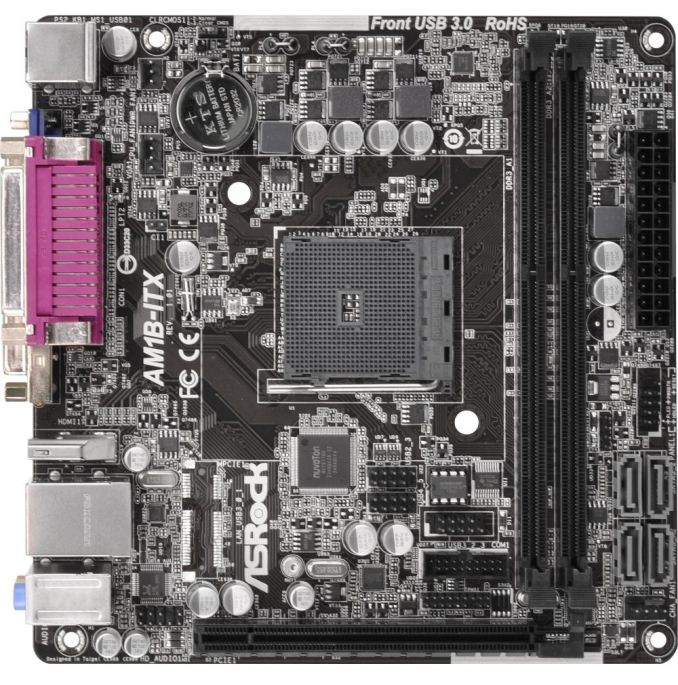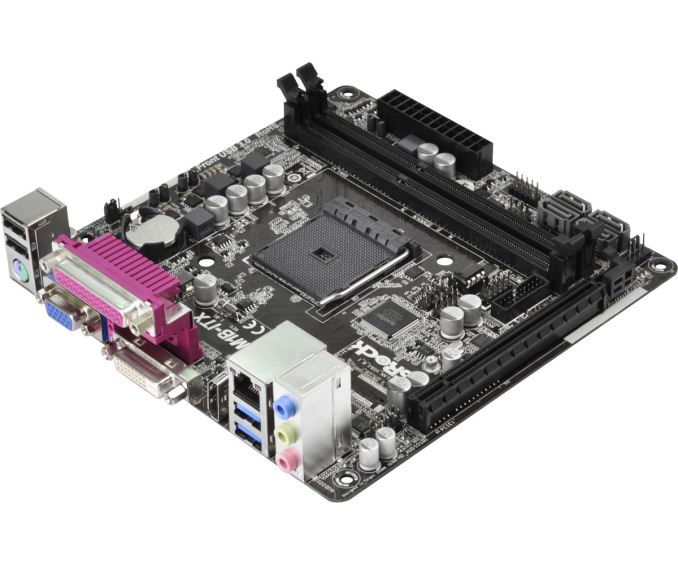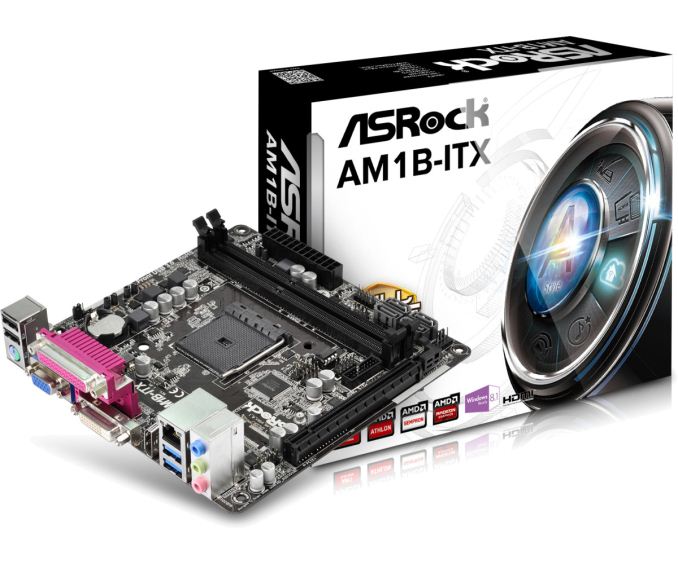The AM1 Kabini Motherboard Preview: Analyzing the Hardware
by Ian Cutress on April 19, 2014 2:00 PM ESTASRock AM1B-ITX
Moving to $40 and above brings a raft of changes – even by moving up a dollar does the AM1 landscape seem to change rapidly enough. To coin the eponymous phrase, ‘And now for something completely different’. The AM1B-ITX does what a motherboard above the base should do: add functionality and reduce complexity. Here we get double the SATA 6 Gbps ports and double the USB 3.0 ports, as well as three fan headers and an integrated parallel port on the rear panel whilst at the same time removing the need of a 4-pin CPU power connector.
ASRock has placed the 24-pin ATX connector, the four SATA 6 Gbps ports and the front panel header outside the DRAM slots (to the right), making cable management with this mini-ITX motherboard a lot easier. The SATA ports are also alternate facing to aid removal of locking SATA cables. Just inside the DRAM slots at the bottom are some of the additional headers – the COM header, the TPM header, the USB 3.0 header and two USB 2.0 headers. It might actually be a little too cramped in there.
Despite removing 4-pin CPU power connector, the top of the motherboard does look extremely busy with all the components on board. Two of the fan headers are in this area at the top left, while the third is at the bottom right. As with the other motherboards in this preview, the main PCIe 2.0 x16 slot runs at x4 mode due to the PCIe lane allocation, and of the lanes that are left ASRock has diverted one each to ASMedia controllers for the extra USB 3.0 and SATA 6 Gbps ports respectively.
While we lose the two extra USB 2.0 ports from the AM1B-M on the previous page, the rear panel gets access to more video outputs and a parallel port instead. When an antiquated port is added to a modern product, some users will bemoan its presence. More often than not, these are added because companies that use old equipment that communicates via the parallel port can cost six figures and is only updated once every few decades, so it is easier to update a $400 PC than a $400000 milling machine.
| ASRock AM1B-ITX | |
| Price | Link |
| Size | Mini-ITX |
| CPU Interface | FS1b |
| Chipset | Kabini |
| Memory Slots |
Two DDR3 DRAM slots, supporting 16 GB Single Channel, 1066-1600 MHz |
| Video Outputs |
VGA (2048x1536 at 60 Hz) DVI-D (1920x1200 at 60 Hz) HDMI (4096x2160 at 24 Hz or 3840x2160 at 30Hz) |
| Onboard LAN | Realtek RTL8111GR |
| Onboard Audio | Realtek ALC662 |
| Expansion Slots | PCIe 2.0 x16 (x4) |
| Onboard SATA/RAID |
2 x SATA 6 Gbps (Chipset) 2 x SATA 6 Gbps (ASMedia ASM1061) |
| USB 3.0 |
2 x USB 3.0 (Chipset) [back panel] 2 x USB 3.0 (ASMedia ASM1042A) [header] |
| Onboard |
4 x SATA 6 Gbps 1 x USB 3.0 Header 2 x USB 2.0 Headers 3 x Fan Headers 1 x COM Header 1 x TPM Header Front Audio Header Front Panel Header |
| Power Connectors | 1 x 24-pin ATX |
| Fan Headers |
1 x CPU (4-pin) 1 x CHA (4-pin) 1 x PWR (3-pin) |
| IO Panel |
1 x PS/2 Combination Port 1 x Parallel Port VGA DVI-D HDMI 2 x USB 2.0 2 x USB 3,0 1 x Gigabit Ethernet Audio Jacks (ALC662) |
| Product Page | Link |
Price wise, the ASRock AM1B-ITX blows the AM1B-M out of the water. For a few extra dollars there are more ports for more of the things most users will want. There is still the issue of that bottom-of-the-barrel Realtek ALC662 though.














64 Comments
View All Comments
coolhardware - Monday, April 21, 2014 - link
Sorry for the error on my part, I got the 5150 and 5350 mixed up :-(As per your original post, where did you see that nice 5150 OC? With an ASUS board should the same type OC be possible with the 5350?
Thanks!
yannigr - Tuesday, April 22, 2014 - link
At techpowerup. http://www.techpowerup.com/forums/threads/amd-kabi...But overclocking on this platform is still a big question mark. At Phoronix for example they also tried to overclock ALL the four processors available on the same motherboard and in ALL cases they had stability problems over 105MHz bus speed. So more time is needed to have a definite idea about the overclocking potential on this platform.
As for 5350 I don't know what frequency it can reach. 2100MHz should be easy I guess with just a multiplier change from 20.5 to 21, gut it does make you wonder why AMD didn't gave 5350 the 21 multiplier in the first place.
tech6 - Sunday, April 20, 2014 - link
The problem with the Kabini platform is that it makes too many sacrifices for too little gain. You can buy an Intel G3220 and an MSI H81M mobo for around $100 and while it may consume 10-15W (on paper) more power it will give you about twice the CPU power.As for real world power consumption, I recently build a G3220 system and even when under 100% max CPU and GPU compute using Hash Suite it never exceeded 60W. Under most everyday loads it used about 40W. Given these numbers it is difficult to make a case for the Kabini platform.
savagemike - Sunday, April 20, 2014 - link
I was contemplating similarly. I also wonder with the increased compute power if getting to idle quicker doesn't also attack any power savings.yannigr - Monday, April 21, 2014 - link
You gone from $60 to $100. This isn't "too little gain". Also you forget that the Kabini platform does have better graphics. Much better graphics. And I am not talking (only) about performance, but compatibility also.So, if you need cpu power and you have $100 you can go for Intel. But if you want a better balanced solution in gpu-cpu performance and keep $30-$40 in your pocket, Kabinis are the best option.
mikato - Wednesday, April 23, 2014 - link
I agree.Carleh - Tuesday, April 22, 2014 - link
Does the G3220 support hardware accelerated video decoding?It does support quicksync, but I'm not sure if quicksync can be used for hw accelerated video playback in all applications (flash includeed).
I know the G3220 is powerful enough to do all the decoding in software, but I see no point in using software video decoding in 2014.
Chicken76 - Sunday, April 20, 2014 - link
I remember from the slides that were presented by AMD at launch, that ECC RAM (unbuffered) was supported. Why isn't there a single motherboard that supports it? In it's current form, Kabini is not an option for building a cheap ZFS storage box.Death666Angel - Sunday, April 20, 2014 - link
Why does the motherboard need to support ECC RAM? I'm pretty sure they are physically identical to normal RAM and since the SoC handles all memory (as with most modern CPUs/APUs), the motherboard has no say in it.Chicken76 - Sunday, April 20, 2014 - link
I'm not sure, but if you're not using error correction on a DIMM, do you still need all the traces? They might not have them all in place, to keep costs to a minimum.Besides, you still need BIOS support for ECC.